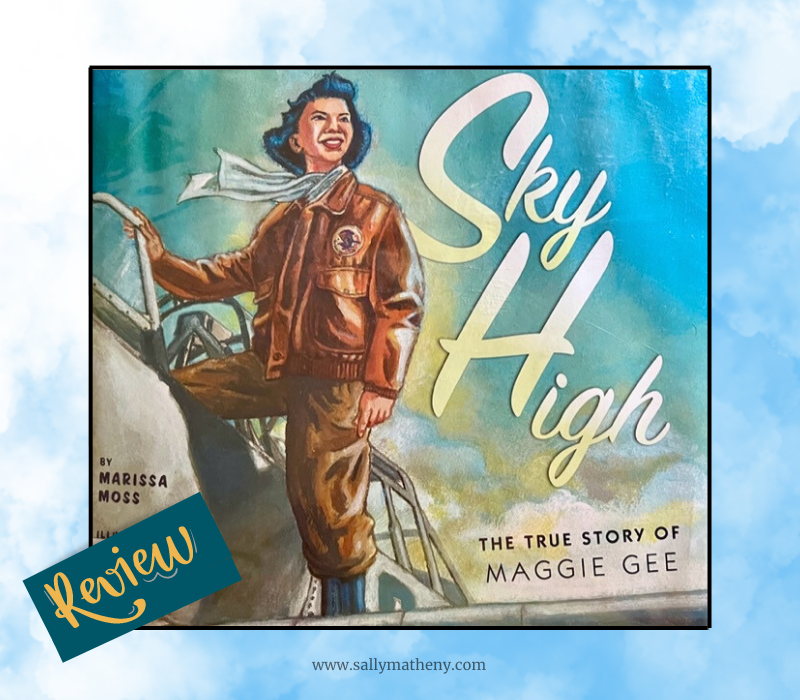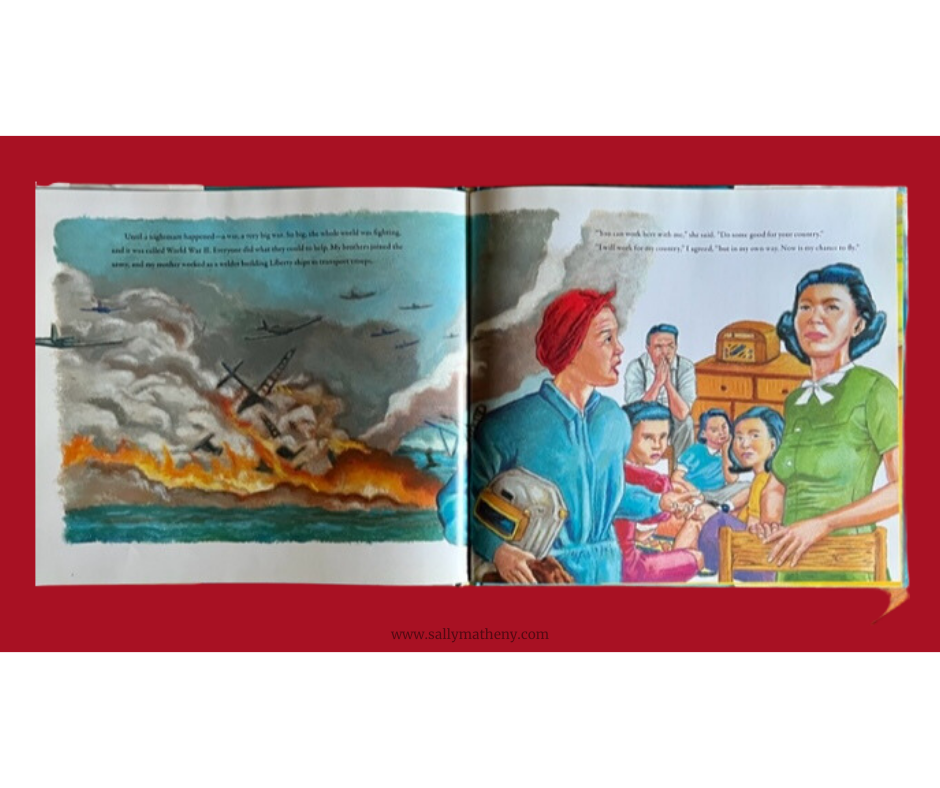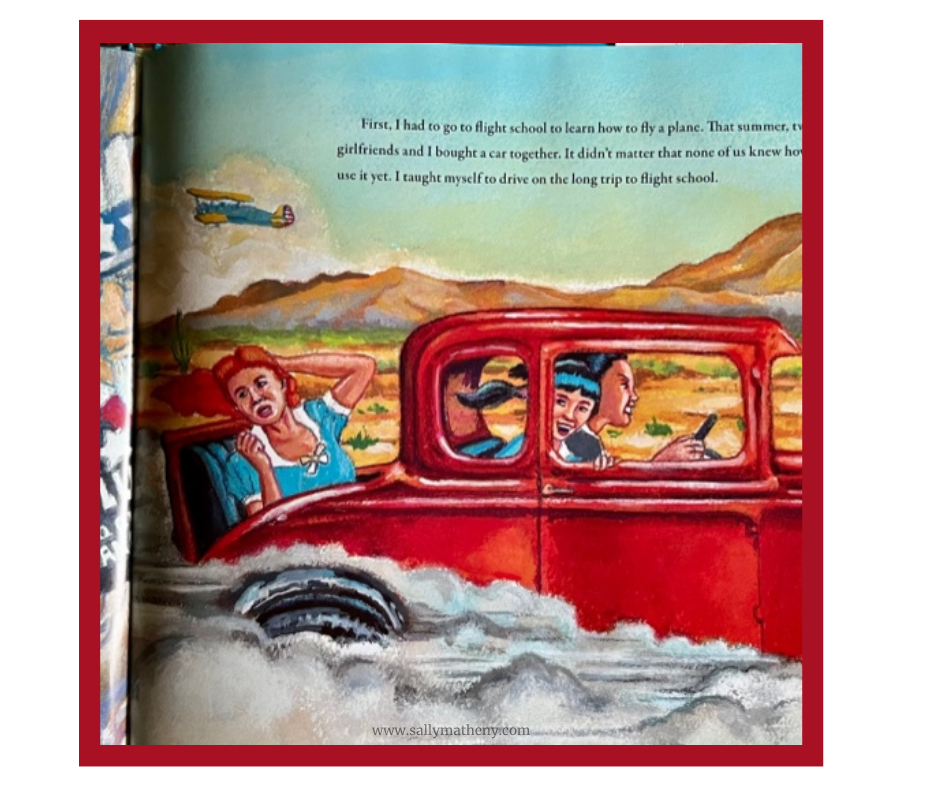
“Sky High” – A WASP Aviation Book Review
In my collection of WWII books is a WASP aviation picture book called “Sky High: The True Story of Maggie Gee.” I thought in celebration of National Aviation Day, I’d feature a review of this award-winning book written by Marissa Moss and illustrated by Carl Angel.
Before Maggie Gee Flies “Sky High”
A third-generation Chinese American, Maggie Gee was born in Berkeley, California on August 5, 1923.
The first twelve pages of this book tell us about Maggie’s childhood. Every Sunday, she and her five siblings visited the airport and enjoyed watching the planes. She desperately wanted to catch a glimpse of one of her heroes, Amelia Earhart. Maggie spent her childhood dreaming of flying someday.
Then, when Maggie was twenty years old, Pearl Harbor was attacked and the United States entered WWII. Maggie’s brothers joined the army and her mother helped to build Liberty ships. Maggie read about the WASP (Women’s Airforce Service Pilots). She knew this would enable her to serve her country and she’d learn how to fly.

Maggie Gee Takes Off
One funny part in the book was when Maggie and her two friends pitched in and bought a car together. They used it to get to the flight school in Texas. Neither of the three young women knew how to drive, but Maggie said she taught herself how to drive on the way to Texas.
She thought WASP training was more challenging than flight school. The book is written in first person and Maggie shares a few of the things she learned to do.

Maggie Gee Flies “Sky High”
After she earned her wings, some of the missions Maggie flew were extremely dangerous. For example, she pulled a banner behind her plane for American fighter pilots to practice target shooting—with live ammunition!
Due to her Asian face, sometimes she was mistaken for a Japanese enemy pilot or a spy. Because she was one of only two Chinese-American WASP pilots, she said she often felt like “an exhibit at the country fair . . . but only for a minute. I got back in my plane and once more was a pilot, plain and simple. I felt big and strong again, and no one could take that feeling away.”
Endnotes
The end of the book includes one page of additional notes from the author about the WASP and Maggie. There’s also a page of photos of the real Maggie Gee and her family.
A few of the interesting facts mentioned are “when the U.S. Air Force started recruiting female pilots, more than 25,000 women applied. Only 1,830 were accepted into flight school; of these, 1.037 graduated.” It also mentions thirty-eight of these pilots died in the line of duty.
My Additional Notes
As a side note, did you know Franklin D. Roosevelt established National Aviation Day in 1939? The celebration day was set on August 19 on Orville Wright’s birthday.
During WWII, even though the WASP flew military aircraft, they were considered civilians and were not granted military benefits. After the war ended, their records became classified and the important work of the WASP was nearly forgotten.
There’s a worthy read over at the Air Force Historical Support Division about the history of the WASP program. The training of women pilots ended in 1944. It would take over thirty years before women would once again be allowed to serve their country as pilots.
In 1977, President Carter paved the way for the WASPs to gain veteran status with limited benefits.
A few years later, the WASPs received WWII Victory Medals and American Theater Campaign Medals.
And, in 2009, the publication year of this picture book, President Obama provided Congressional Gold Medals to the WASPs.
Recommendation
The bright watercolor illustrations and the simple, yet intriguing storyline of this book will hold the attention of children ages five to nine. There are no gory depictions of war. The content is not unsettling, but rather uplifting. The focus is on Maggie pursuing her dream of flying.
In addition to National Aviation Day, you could also introduce this book to students on Memorial Day, Veterans Day, during a study of WWII or aviation history. or anytime you’d like to share a story about courage.





6 Comments
JD Wininger
Thank you for sharing about Mrs. Gee Ms. Sally. Sounds like a fun read, especially for young ladies who want to soar above the others.
Sally Matheny
Hi, Mr. J.D.
It was fun reading about this woman in history I’d never heard of before!
Gayle Veitenheimer
Fascinating!
Sally Matheny
Hi, Gayle. I don’t think we will ever run out of fascinating human interest stories–especially from WWII!
Kathy
What an amazing woman! Thanks for reviewing this book and telling some of her story!
Sally Matheny
Hi, Kathy. She certainly was a woman who wasn’t afraid to pursue her dreams of flying no matter what the obstacles were. I thought her story might inspire others.